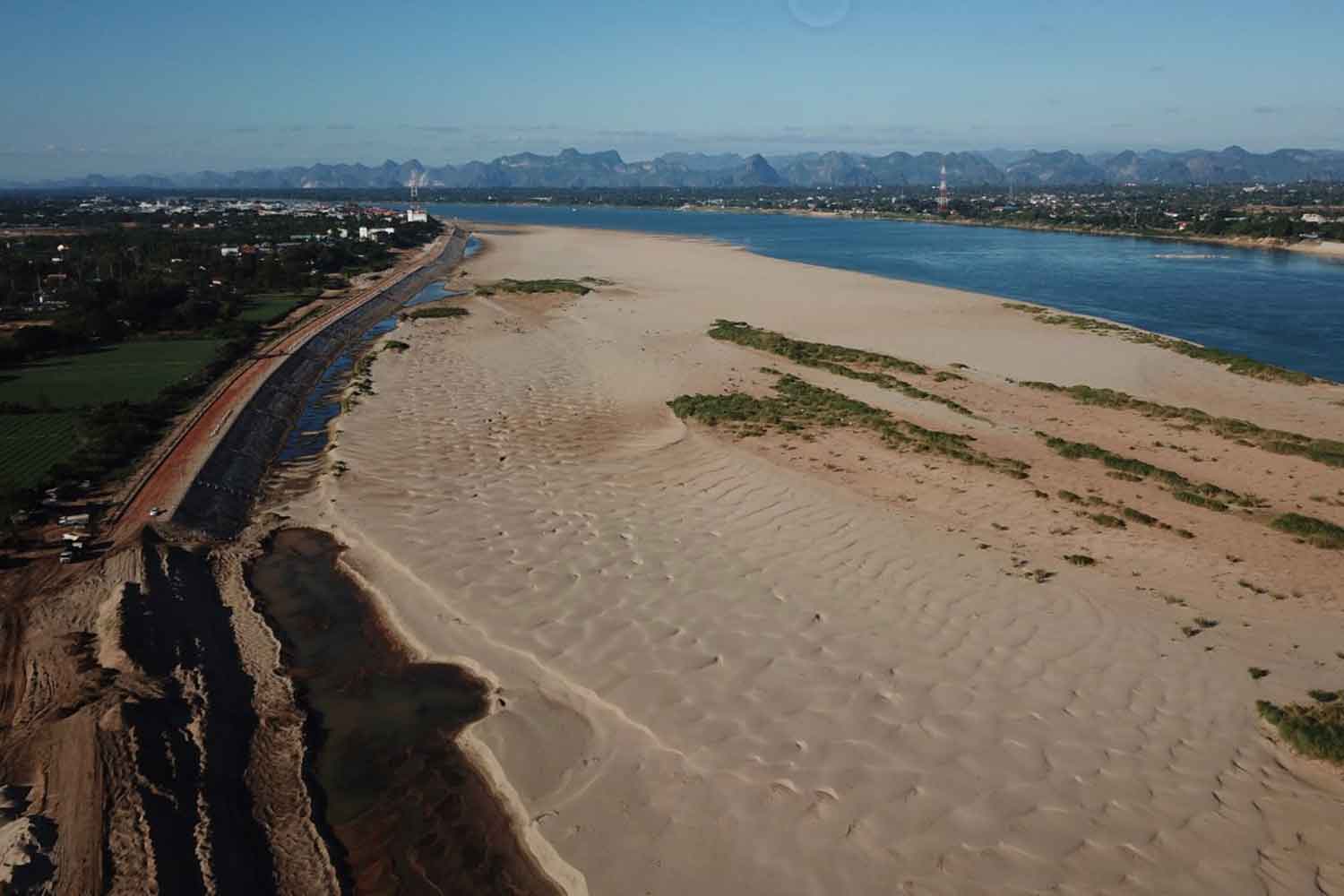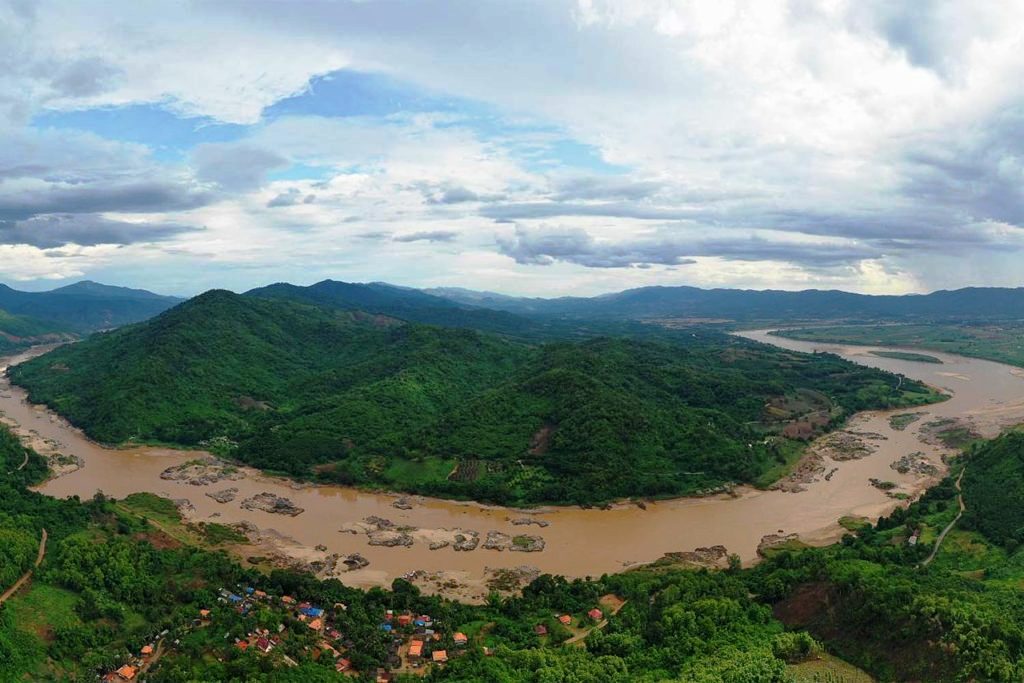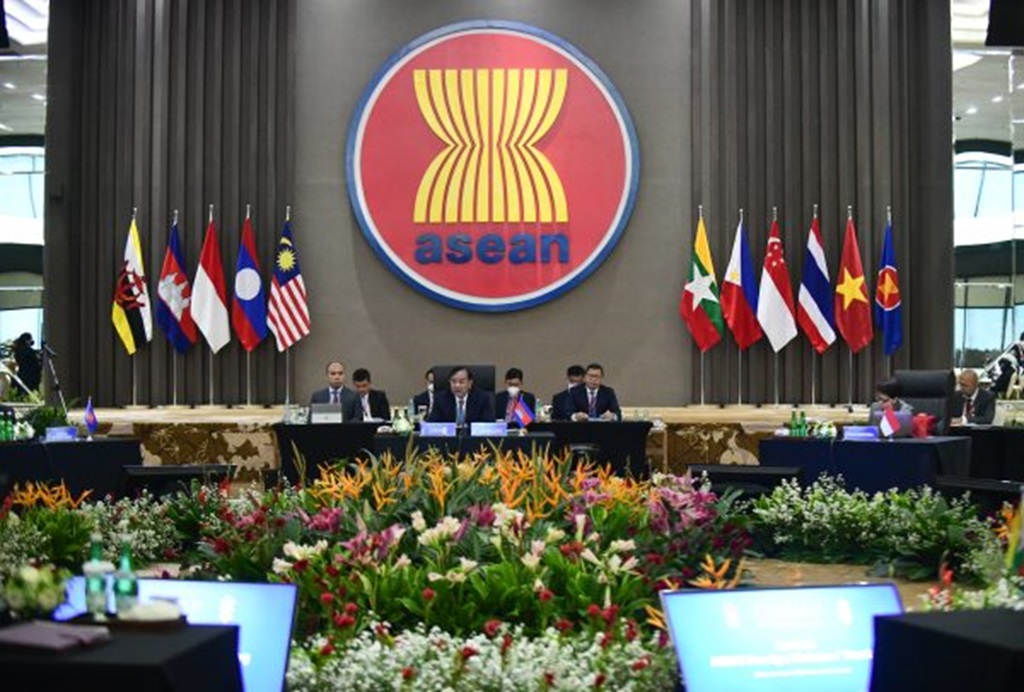ASEAN
Study Finds China Held Back Water on Mekong River During Drought

China’s Mekong River dams held back huge amounts of water during a damaging drought effecting downstream countries last year. Even more China had higher-than-average water levels upstream, a US research company reports.
China’s Communist regime has of course disputed the findings, saying there was low rainfall during last year’s monsoon season on its portion of the 4,350km river.
The findings by Eyes on Earth Inc, a research and consulting company specializing in water, published in a US-government funded study, could complicate tricky discussions between China and other Mekong countries on how to manage the river. The Mekong River supports 60 million people as it flows past Laos, Myanmar, Thailand and through Cambodia and Vietnam.
Drought on Lower Mekong Countries
Last year’s the Lower Mekong levels were at the lowest levels in more than 50 years. Devastating farmers and fishermen. which also saw the massive river recede to expose sandbanks along some stretches. Others areas turned from its usual murky brown to bright blue because waters were so shallow.
“If the Chinese are stating that they were not contributing to the drought, the data does not support that position,” said Alan Basist, a meteorologist and president of Eyes on Earth. They conducted the study with funding from the US State Department’s Lower Mekong Initiative.
Instead, satellite measurements of “surface wetness” in China’s Yunnan province, through which the Upper Mekong flows, suggest the region in 2019 actually had slightly above-average combined rainfall and snow-melt during the May to October wet season.
But water levels measured downstream from China along the Thai-Lao border were at times up to 3m lower than they should have been, the group said in the study.
That suggests China is “not letting the water out during the wet season, even when the restriction of water from China has a severe impact of the drought experienced downstream,” Mr Basist said.
China controls Mekong River Data

The effect of China’s 11 dams on the upper Mekong has long been debated. Furthermore data has been scarce because China does not release detailed records. Above all data on of how much water the dams are using to fill their reservoirs. Eyes on Earth says the reservoirs have a combined capacity of more than 47 billion cubic meters.
China, which has no formal water treaties with the lower Mekong countries, promised to cooperate on management of the river. It also promised to investigate the causes of last year’s record drought.
But the US, which has been challenging China’s growing influence in Southeast Asia, has said that Beijing essentially controls the Mekong. Last year in Bangkok, US Secretary of State Mike Pompeo blamed the drought on “China’s decision to shut off water upstream”.
The study used satellite data taken with Special Sensor Microwave Imager/Sounder (SSMI/S) technology to detect water on the surface from rain and snowmelt in China’s portion of the Mekong River Basin from 1992 to late 2019.
It then compared that data with river-level readings by the Mekong River Commission at Thailand’s Chiang Saen Hydrological Station, the closest station to China, to create a predictive model of “natural” levels for the river given a certain amount of upstream rainfall and snowmelt.
In the early years of the data, from 1992, the predictive model and the river measurements tracked generally closely.
China Dismisses finding on Dams

But starting in 2012, when the larger of China’s upper Mekong hydropower dams came online, the model and the river level readings started to diverge most years, coinciding with periods of the Chinese dams’ reservoirs filling up during rainy seasons and releasing water during the dry season.
The difference was especially pronounced in 2019, Mr Basist said. The study focused only on waters flowing out of China, and did not look further downstream, where Laos opened two new mainstream Mekong dams in late 2019.
China of course dismissed the findings.
“The explanation that China’s dam building on the Lancang River is causing downstream droughts is unreasonable,” the Ministry of Foreign Affairs said in a statement to Reuters, referring to the river by its Chinese name.
The ministry said Yunnan province saw serious drought last year and reservoir volumes at China’s dams on the river fell to their historically lowest levels.
“Despite this, China has continued to do its utmost to guarantee reasonable discharge volumes” to countries downstream, the ministry said.
That assertion, however, is inconsistent with the new study’s data, said Brian Eyler, Southeast Asia programme director of the Stimson Center think-tank in Washington.
“Either Beijing is lying or their dam operators are lying to them. Somewhere, someone isn’t telling the truth,” Mr Eyler said.

ASEAN
Thailand Touts Peace Plan With ASEAN Partners for Myanmar

Thailand has urged that three or more ASEAN member countries collaborate to engage with Myanmar’s military regime in order to alleviate the crisis and bring peace to the conflict-torn country, while keeping steadfast in its commitment to humanitarian aid and peace promotion.
Foreign Affairs Ministry spokesman Nikorndej Balankura said on Wednesday that Thailand had coordinated with Laos, the current Asean chair, to arrange what it terms Asean “Troika” and “Troika plus” talks to restore peace in Myanmar.
The Asean Troika is a community of foreign ministers from the bloc’s previous, current, and prospective chair countries [Indonesia, Laos, and Malaysia]. The term “plus” refers to other Asean members who are interested in promoting peace or concerned about the problem.
Mr Nikorndej stated that the proposed meetings are most likely to take place in Thailand and restated the country’s willingness to mediate negotiations between Myanmar’s junta and resistance organizations.
He stated that the ongoing violence is not between Thailand and Myanmar, and that the Thai government will provide humanitarian assistance to all groups affected by the fighting in accordance with national security, international relations, and human rights standards.
He emphasized that the crisis impacts all countries, including Thailand, which shares a border with Myanmar.
“Thailand is a peace advocate, thus we must stress our role as an active promoter of peace. This is evident in our willingness to mediate negotiations between Myanmar’s conflicting parties. “If they agree, we’re ready,” he stated.
Border Trade Resumes
According to Mr Nikorndej, because the majority of the refugees have returned to Myanmar, the situation is not considered severe, and the consequences on Thailand are limited, affecting border trade only temporarily.
The government committee overseeing the situation along the Thai-Myanmar border, chaired by Deputy Prime Minister and Foreign Minister Parnpree Bahiddha-Nukara, is considering forming sub-committees with the National Security Council (NSC) to make the selections.
He highlighted that the situation along the Thai-Myanmar border has improved over the last 48 hours, with no reports of firing from locals. However, the committee will keep an eye on the situation, which is fluid.
During Mr Parnpree’s visit to Tak’s Mae Sot area on Tuesday afternoon, he stated that there has been no fighting at the 2nd Thailand-Myanmar Friendship Bridge since Sunday, and the majority of the refugees who left the fighting over the weekend have since returned.
He stated that the most important thing is that Thai residents be reassured that the government is taking steps to alleviate the effects of the Myanmar conflict on their livelihoods.
“Our agencies have response plans and people can rest assured that we are giving top priority to their safety,” he went on to say. When asked when the Mae Sot checks will reopen, he said they are expected to do so soon because both sides in Myanmar understand the importance of the 2nd Thai-Myanmar Friendship Bridge as a crucial border commerce route.
Residents Return to Myanmar
Meanwhile, the final group of 658 Myanmar refugees who sought safety in Mae Sot on Wednesday voluntarily chose to return once the situation in Myawaddy eased, according to local officials.
They were provided needs, such as medicines, before crossing the Moei River back to Myawaddy. Local officials and charity workers escorted them away.
According to the most recent reports, the checkpoint at the 1st Thai-Myanmar Friendship Bridge reopened on Wednesday, and junta troops who had fled to the 2nd Thai-Myanmar Friendship Bridge had returned to their barracks at the 275th Infantry Battalion.
On Wednesday, Reuters reported that a Myanmar rebel force has evacuated from Myawaddy following a military counteroffensive.
According to a spokesman for the Karen National Union (KNU), the “temporary retreat” from the town of Myawaddy occurred after junta soldiers returned to the crucial strategic location, which serves as a conduit for more than $1 billion in yearly foreign trade.
ASEAN’s Influence Over Myanmar
ASEAN, or the Association of Southeast Asian Nations, is a regional intergovernmental organization made up of ten Southeast Asian countries. Founded in 1967, its mission is to foster economic, political, and social cooperation among its members. These countries are Brunei, Cambodia, Indonesia, Laos, Malaysia, Myanmar, the Philippines, Singapore, Thailand, and Vietnam.
ASEAN plays an important influence in the area. It promotes economic integration through initiatives such as the ASEAN Economic Community, which improve trade and investment flows. The group also addresses security, climate change, and human rights. It has tried to create a single market, promote sustainable growth, and deepen ties with its international partners.
Despite obstacles such as managing divergent interests, ASEAN remains influential. Its combined market of approximately 650 million people, as well as its strategic location between India and China, lend it economic weight. The group’s goal is to maintain regional stability while furthering its members’ common interests on the global stage.
ASEAN
Thailand Touts Peace Plan With ASEAN Partners for Myanmar

Thailand has urged that three or more ASEAN member countries collaborate to engage with Myanmar’s military regime in order to alleviate the crisis and bring peace to the conflict-torn country, while keeping steadfast in its commitment to humanitarian aid and peace promotion.
Foreign Affairs Ministry spokesman Nikorndej Balankura said on Wednesday that Thailand had coordinated with Laos, the current Asean chair, to arrange what it terms Asean “Troika” and “Troika plus” talks to restore peace in Myanmar.
The Asean Troika is a community of foreign ministers from the bloc’s previous, current, and prospective chair countries [Indonesia, Laos, and Malaysia]. The term “plus” refers to other Asean members who are interested in promoting peace or concerned about the problem.
Mr Nikorndej stated that the proposed meetings are most likely to take place in Thailand and restated the country’s willingness to mediate negotiations between Myanmar’s junta and resistance organizations.
He stated that the ongoing violence is not between Thailand and Myanmar, and that the Thai government will provide humanitarian assistance to all groups affected by the fighting in accordance with national security, international relations, and human rights standards.
He emphasized that the crisis impacts all countries, including Thailand, which shares a border with Myanmar.
“Thailand is a peace advocate, thus we must stress our role as an active promoter of peace. This is evident in our willingness to mediate negotiations between Myanmar’s conflicting parties. “If they agree, we’re ready,” he stated.
Border Trade Resumes
According to Mr Nikorndej, because the majority of the refugees have returned to Myanmar, the situation is not considered severe, and the consequences on Thailand are limited, affecting border trade only temporarily.
The government committee overseeing the situation along the Thai-Myanmar border, chaired by Deputy Prime Minister and Foreign Minister Parnpree Bahiddha-Nukara, is considering forming sub-committees with the National Security Council (NSC) to make the selections.
He highlighted that the situation along the Thai-Myanmar border has improved over the last 48 hours, with no reports of firing from locals. However, the committee will keep an eye on the situation, which is fluid.
During Mr Parnpree’s visit to Tak’s Mae Sot area on Tuesday afternoon, he stated that there has been no fighting at the 2nd Thailand-Myanmar Friendship Bridge since Sunday, and the majority of the refugees who left the fighting over the weekend have since returned.
He stated that the most important thing is that Thai residents be reassured that the government is taking steps to alleviate the effects of the Myanmar conflict on their livelihoods.
“Our agencies have response plans and people can rest assured that we are giving top priority to their safety,” he went on to say. When asked when the Mae Sot checks will reopen, he said they are expected to do so soon because both sides in Myanmar understand the importance of the 2nd Thai-Myanmar Friendship Bridge as a crucial border commerce route.
Residents Return to Myanmar
Meanwhile, the final group of 658 Myanmar refugees who sought safety in Mae Sot on Wednesday voluntarily chose to return once the situation in Myawaddy eased, according to local officials.
They were provided needs, such as medicines, before crossing the Moei River back to Myawaddy. Local officials and charity workers escorted them away.
According to the most recent reports, the checkpoint at the 1st Thai-Myanmar Friendship Bridge reopened on Wednesday, and junta troops who had fled to the 2nd Thai-Myanmar Friendship Bridge had returned to their barracks at the 275th Infantry Battalion.
On Wednesday, Reuters reported that a Myanmar rebel force has evacuated from Myawaddy following a military counteroffensive.
According to a spokesman for the Karen National Union (KNU), the “temporary retreat” from the town of Myawaddy occurred after junta soldiers returned to the crucial strategic location, which serves as a conduit for more than $1 billion in yearly foreign trade.
ASEAN’s Influence Over Myanmar
ASEAN, or the Association of Southeast Asian Nations, is a regional intergovernmental organization made up of ten Southeast Asian countries. Founded in 1967, its mission is to foster economic, political, and social cooperation among its members. These countries are Brunei, Cambodia, Indonesia, Laos, Malaysia, Myanmar, the Philippines, Singapore, Thailand, and Vietnam.
ASEAN plays an important influence in the area. It promotes economic integration through initiatives such as the ASEAN Economic Community, which improve trade and investment flows. The group also addresses security, climate change, and human rights. It has tried to create a single market, promote sustainable growth, and deepen ties with its international partners.
Despite obstacles such as managing divergent interests, ASEAN remains influential. Its combined market of approximately 650 million people, as well as its strategic location between India and China, lend it economic weight. The group’s goal is to maintain regional stability while furthering its members’ common interests on the global stage.
ASEAN
7 key things Changed for Indian Stock market Overnight – Gift Nifty, tech stocks rally to oil prices

(CTN News) – Indian stock market: The domestic equity market is projected to open lower on Tuesday, mirroring mixed global market cues ahead of global central banks’ monetary policy meetings.
Asian markets fell as US stock indices closed higher overnight, boosted by mega-cap growth stocks.
For additional interest rate clues, market investors will look to the Bank of Japan’s monetary policy choices later today and the US Federal Reserve’s policy this week. On Monday, the Indian stock market indices finished the turbulent day higher, powered by key metals and auto giants.
The Sensex rose 104.99 points, or 0.14%, to close at 72,748.42, while the Nifty 50 advanced 32.35 points, or 0.15%, to 22,055.70. “We expect the markets to consolidate in the coming days, while the broader market may remain subdued,” said Siddhartha Khemka, Head of Retail Research at Motilal Oswal Financial Services Ltd.
Here are significant worldwide market indications for the Sensex today:
Asian marketplaces
Asian markets fell on Tuesday ahead of the Bank of Japan’s monetary policy decision. After 17 years of negative interest rate policy, the Bank of Japan will likely cease it.
Japan’s Nikkei 225 lost 0.5% at the outset, while the Topix remained steady. South Korea’s Kospi fell 0.8%, while the Kosdaq dropped 0.4%. Hong Kong’s Hang Seng index futures showed a dismal start.
Gift Nifty Today
Today, the Gift Nifty was trading at 22,060, a markdown of nearly 70 points from the previous close of the Nifty futures. This indicates a gap-down start for Indian stock market indices.
US stock market indices closed higher on Monday, powered by mega cap growth stocks, as investors awaited the Federal Reserve’s policy meeting this week.
The Dow Jones Industrial Average rose 75.66 points, or 0.20%, to 38,790.43, while the S&P 500 increased 32.33 points, or 0.63%, to 5,149.42. The Nasdaq Composite closed 130.27 points, or 0.82% higher, at 16,103.45.
Tesla shares rose 6.3%, while Nvidia shares rose 0.7%. Xpeng’s US-listed shares rose 1.9%, Boeing’s stock price fell 1.5% and Super Micro Computer’s stock dropped 6.4%.
On Monday, technology megacap stocks in the US soared, with the Nasdaq 100 gaining about 1% and the ‘Magnificent Seven’ tech megacaps rising twice as much.
Google’s parent Alphabet shares rose 4.4% after Bloomberg News reported that Apple Inc. is discussing incorporating Google’s Gemini artificial intelligence engine inside the iPhone. Apple shares rose 0.6%.
Nvidia’s stock price jumped 0.7% after CEO Jensen Huang unveiled new chips to extend the company’s supremacy in AI computing. Tesla shares rose 6.3% after the electric carmaker announced that it would shortly raise the price of its Model Y EVs in areas of Europe.
Indian stock market Oil Prices:
Crude oil prices rose further following Ukrainian drone assaults on Russian refineries and OPEC supply cutbacks. Brent crude, the global standard, rose 0.06% to $86.94 per barrel after rallying 1.8% on Monday to its highest closing since late October. West Texas Intermediate was trading 0.06% higher at $82.77.
Bank of Japan
The Bank of Japan is anticipated to abandon its eight-year negative interest rate policy on Tuesday and raise interest rates for the first time in 17 years. If the nine-member board deems the conditions are right, the BOJ will set the overnight call rate as its new objective and guide it in a range of 0-0.1% by paying 0.1% interest on excess reserves held by financial institutions at the central bank, according to Reuters.
Japan’s 10-year government bond rate increased by one basis point (bp) to 0.765%, while the two-year yield increased by one bp to 0.19%.
US Treasury Yields
The benchmark US 10-year Treasury yields rose to three-week highs on Monday, ahead of the Federal Reserve’s meeting this week. The yield on 10-year notes reached 4.348%, up nearly 5 basis points on the day and the highest since February 23. According to Reuters, two-year yields rose to 4.751%, the highest level since February 23. The yield curve inversion between two-year and ten-year notes narrowed by 2 basis points to minus 40.
Related CTN News:
-

 News3 years ago
News3 years agoLet’s Know About Ultra High Net Worth Individual
-
Entertainment2 years ago
Mabelle Prior: The Voice of Hope, Resilience, and Diversity Inspiring Generations
-

 Health3 years ago
Health3 years agoHow Much Ivermectin Should You Take?
-

 Tech2 years ago
Tech2 years agoTop Forex Brokers of 2023: Reviews and Analysis for Successful Trading
-

 Lifestyles3 years ago
Lifestyles3 years agoAries Soulmate Signs
-

 Movies2 years ago
Movies2 years agoWhat Should I Do If Disney Plus Keeps Logging Me Out of TV?
-

 Health3 years ago
Health3 years agoCan I Buy Ivermectin Without A Prescription in the USA?
-

 Learning2 years ago
Learning2 years agoVirtual Numbers: What Are They For?